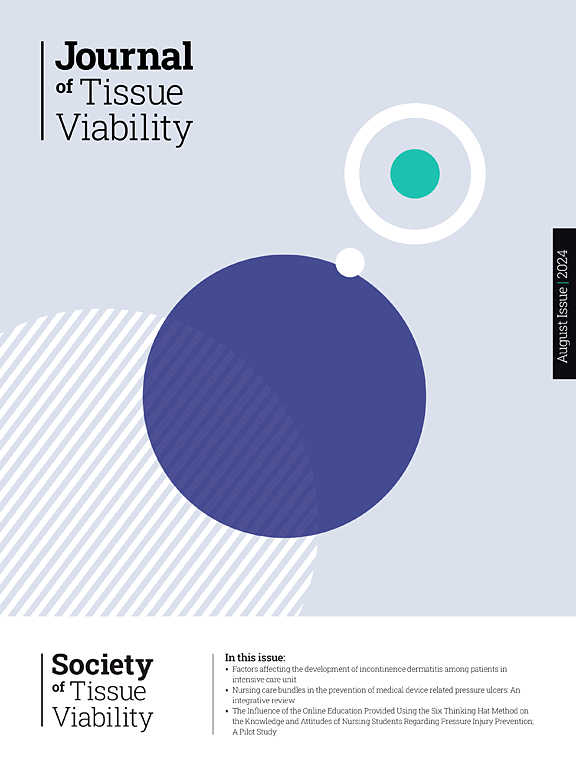Exploring the definition of surgical wound dehiscence in literature: a Scoping Review
IF 2.4
3区 医学
Q2 DERMATOLOGY
引用次数: 0
Abstract
Background
Surgical wound dehiscence (SWD) is interpreted differently amongst healthcare professionals due to a lack of uniformity in definitions in literature. Inconsistent defining impedes accurate diagnosis, appropriate care, intercollegiate consultation, and benchmarking. Despite the introduction of a consensus-driven definition by the World Union of Wound Healing Societies (WUWHS) in 2018, its application in literature and clinical practice remains unclear.
A objectives
This scoping review aims to systematically explore the literature to identify existing SWD definitions, provide an overview, identify knowledge gaps, and extract articles that reference the WUWHS definition.
Methods
This review was performed in accordance with the PRISMA-ScR guidelines and Joanna Briggs Institute Methodology for Scoping Reviews. A systematic literature search was performed through MEDLINE, EMBASE, Cochrane Library and Google Scholar. Eligibility screening and data extraction were independently performed by two researchers.
Results
This study included 34 articles: 28 systematic reviews, two randomized clinical trials, three retrospective studies, and one book chapter. SWD was defined in different ways, such as “breakdown/disruption of the surgical wound” (n = 17), ”separation/splitting apart of the wound edges” (n = 13), “gaping/re-opened wound” (n = 7), mechanical failure (n = 2), or infection (n = 1). Other studies defined SWD in relation to its depth (skin layers involved) or length over the incision, both complete and partial (n = 9). One study referenced the WUWHS definition.
Conclusion
Existing literature demonstrates a substantial variety in defining SWD, and little adoption of the WUWHS definition following its introduction in 2018. Uniform use of the definition should be considered as this will improve the quality of care.
探索文献中手术伤口开裂的定义:范围界定。
背景:由于文献中的定义不统一,医护人员对手术伤口开裂(SWD)的解释也不尽相同。不一致的定义妨碍了准确诊断、适当护理、跨学院咨询和基准设定。尽管世界伤口愈合学会联盟(WUWHS)于 2018 年推出了以共识为导向的定义,但其在文献和临床实践中的应用仍不明确:本范围界定综述旨在系统地探索文献,以确定现有的 SWD 定义,提供概述,确定知识差距,并摘录引用 WUWHS 定义的文章:本综述根据 PRISMA-ScR 指南和乔安娜-布里格斯研究所的范围界定综述方法进行。通过 MEDLINE、EMBASE、Cochrane Library 和 Google Scholar 进行了系统的文献检索。资格筛选和数据提取由两名研究人员独立完成:本研究包括 34 篇文章:结果:本研究共纳入 34 篇文章:28 篇系统综述、2 篇随机临床试验、3 篇回顾性研究和 1 篇书籍章节。对 SWD 的定义各不相同,如 "手术伤口破裂/中断"(17 篇)、"伤口边缘分离/裂开"(13 篇)、"伤口裂开/重新开放"(7 篇)、机械故障(2 篇)或感染(1 篇)。其他研究根据伤口深度(涉及的皮肤层)或切口长度(包括完全切口和部分切口)对 SWD 进行了定义(9 项)。一项研究参考了 WUWHS 的定义:现有文献表明,对 SWD 的定义存在很大差异,而在 2018 年引入 WUWHS 定义后,几乎没有采用该定义。应考虑统一使用该定义,因为这将提高护理质量。
本文章由计算机程序翻译,如有差异,请以英文原文为准。
求助全文
约1分钟内获得全文
求助全文
来源期刊

Journal of tissue viability
DERMATOLOGY-NURSING
CiteScore
3.80
自引率
16.00%
发文量
110
审稿时长
>12 weeks
期刊介绍:
The Journal of Tissue Viability is the official publication of the Tissue Viability Society and is a quarterly journal concerned with all aspects of the occurrence and treatment of wounds, ulcers and pressure sores including patient care, pain, nutrition, wound healing, research, prevention, mobility, social problems and management.
The Journal particularly encourages papers covering skin and skin wounds but will consider articles that discuss injury in any tissue. Articles that stress the multi-professional nature of tissue viability are especially welcome. We seek to encourage new authors as well as well-established contributors to the field - one aim of the journal is to enable all participants in tissue viability to share information with colleagues.
 求助内容:
求助内容: 应助结果提醒方式:
应助结果提醒方式:


